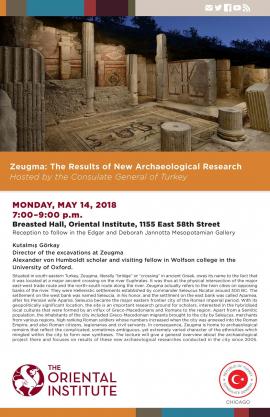The Consulate General of Turkey presents:
Zeugma: The Results of New Archaeological Research
Kutalmiş Görkay
Director of Excavations at Zeugma
Alexander von Humboldt Scholar and Visiting Fellow in Wolfson College in the University of Oxford
Monday
May 14, 2018
7:00–9:00 PM
Breasted Hall of the Oriental Institute
Reception to follow in the Edgar and Deborah Jannotta Mesopotamian Gallery
Situated in south-eastern Turkey, Zeugma, literally "bridge" or "crossing" in ancient Greek, owes its name to the fact that it was located at a major ancient crossing on the river Euphrates. It was thus at the physical intersection of the major east-west trade route and the north-south route along the river. Zeugma actually refers to the twin cities on opposing banks of the river. They were Hellenistic settlements established by commander Seleucus Nicator around 300 BC. The settlement on the west bank was named Seleucia, in his honor, and the settlment on the east bank was called Apamea, after his Persian wife Apama. Seleucia became the major eastern frontier city of the Roman Imperial period. With its geopolitically significant location, the site is an important research ground for scholars, interested in the hybridised local cultures that were formed by an influx of Greco-Macedonians and Romans to the region. Apart from a Semitic population, the inhabitants of the city included Greco-Macedonian migrants brought to the city by Seleucus, merchants from various regions, high ranking Roman soldiers whose numbers increased when the city was annexed into the Roman Empire, and also Roman citizens, legionaries and civil servants. In consequence, Zeugma is home to archaeological remains that reflect the complicated, sometimes ambiguous, yet extremely varied character of the ethnicities which mingled within the city to form new syntheses. The lecture will give a general overview about the archaeological project there and focuses on results of these new archaeological researches conducted in the city since 2005.


